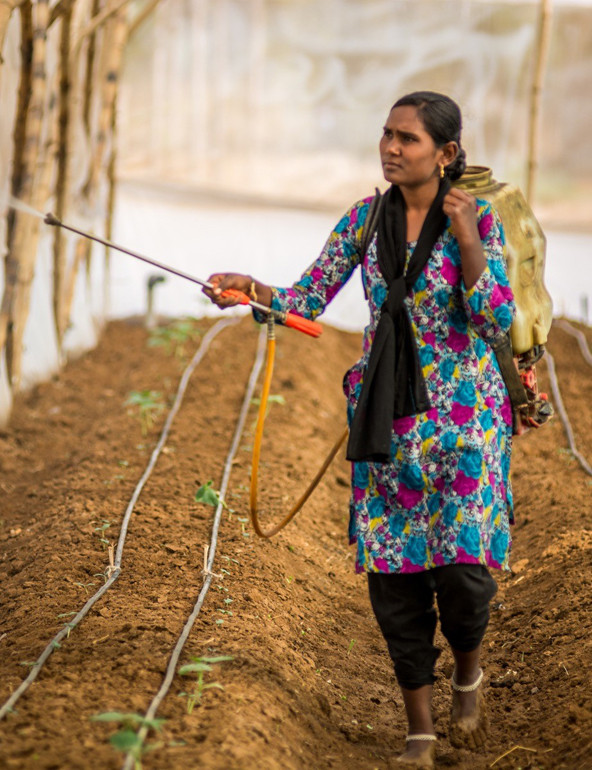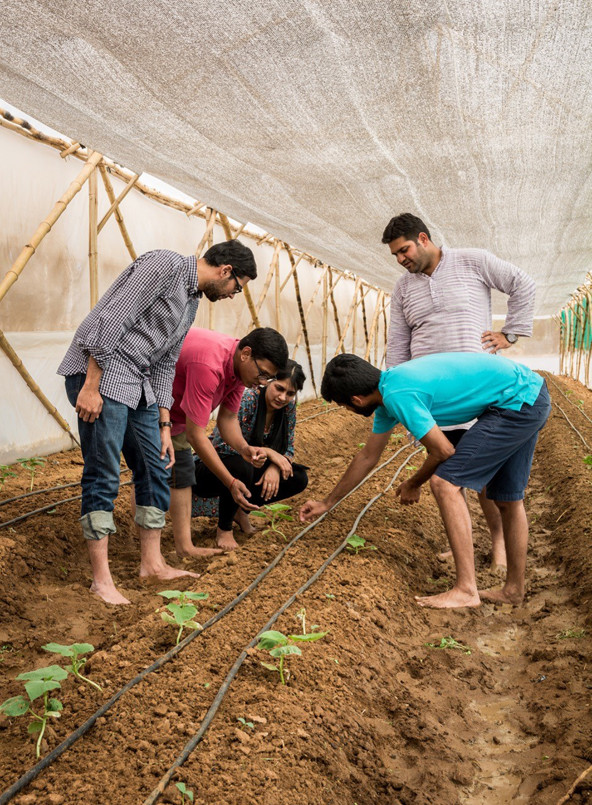 Farmer Reshma spraying water to reduce temperature. (Photo by Venu Gopal Goundla)
Farmer Reshma spraying water to reduce temperature. (Photo by Venu Gopal Goundla)
Ashok Goud is small farmer in the state of Telangana in southern India who has been farming two acres of land for the past 20 years. When his paddy crop failed last year due to drought, he planted maize. When the market for maize fell, he learned how to grow tomatoes with help from the local seed store’s owner. When his land was unusable six months in a year due to heat waves exceeding 115 degrees Fahrenheit (46 Celsius), he ran a small store on the side to support his family. Ashok is an entrepreneur, and his dedication to an often unforgiving profession is unwavering.
More than a billion people in the world are employed in agriculture, and in India, one out of four people are farmers or agricultural workers. Like Ashok, these smallholder farmers—who constitute 85 percent of farmers globally—make up one of the largest constituencies among the world’s poor. They farm on a hectare or two of land, and often lack access to the right seeds and fertilizers, technology, and knowledge, which in turn makes their yields far lower than they could be. Markets fail them when they try to sell their produce. On top of these challenges, they are increasingly affected by climate change.
Despite all of this, smallholder farmers like Ashok manage to persevere. This perseverance is important for the livelihood of individual farmers and the millions who collectively rely on smallholder farmers for food security.
Farmers find this success when they get support from the beginning to the end of the agricultural process. All they need is the access to knowledge, technology and markets to help fan that spark of perseverance into a bright flame of success. The question we need to ask ourselves is why so few bright spots exist among smallholder farmers? Why is it that more than 80 years since micro-irrigation was commercialized, it has reached less than 0.2 percent of agricultural land in India? Why is it that with 80 percent of the rural poor owning cellphones, farmers still don’t have concrete access to market information and prices? Most importantly, why does the farmer who feeds us still starve?
Are you enjoying this article? Read more like this, plus SSIR's full archive of content, when you subscribe.
The answer lies in how we view smallholder farmers. Almost a decade ago, the late C.K. Prahlad asked us to look at the world’s poor as active consumers, not passive beneficiaries, in his book The Fortune at the Bottom of the Pyramid. But they are more than consumers; they are entrepreneurs and risk takers. These entrepreneurs need innovators who help bring new thinking to their work. As Prahlad argued, this can’t be done using old technologies and one-size-fits-all methods. Innovators must adapt every technology, practice, and process that has worked in mainstream agriculture so that small farmers can make the best use of them.
We must also make sure to infuse this technology and know-how into all parts of agriculture. Farmers face risk of failure in every stage—planting, harvesting or selling—that can throw them back into the poverty cycle. If Ashok had bought drip irrigation but did not know how to use it, he would’ve failed. If he knew how to use it but couldn’t sell his high-quality produce in the market, he would’ve failed. To solve this, we need to learn from one of the latest trends in Silicon Valley: “the full stack approach.” This approach makes the entrepreneur responsible for every part of the experience. Uber, for example, handles everything from connecting you with a driver to managing payment and ratings. In the context of agriculture, the full stack approach includes helping farmers identify what to grow and how to grow it, what technology to use, and when and where to sell at what price.
Take the story of Professional Assistance for Development Action (PRADAN), an NGO set up in 1983 based on the idea that simple rural technologies and the right person acting as a catalyst can transform rural communities. Each year, PRADAN recruits young graduates from the best colleges in India and places them as “professionals” in extremely low-income, rural communities. These professionals are responsible for raising levels of education, helping communities add value to their products for the marketplace, creating collectives to improve their bargaining power, and ultimately raising their incomes and improving livelihoods.
Twenty years ago in rural Jharkhand, one of the poorest states in India, PRADAN saw the opportunity to create supplemental income for farmer households through raising poultry. Understanding that traditional poultry farms were too advanced and costly for these communities, they created a simple “backyard poultry kit”—with feed, disease management tools, training manuals, and other incidentals—that could house 10-40 birds and that any farmer could easily install and operate. PRADAN’s professionals introduced the concept to the communities, delivered the kits, ensured the availability of chicks, and slowly and steadily organized these small-scale poultry producers into cooperatives—a full stack approach. As of 2015, PRADAN’s backyard poultry initiative, which constitutes only a fraction of its impact, positively affects 9,000 families organized in 21 cooperatives, with sales of approximately $37 million.
Inspired by the spark we’ve seen in farmers like Ashok and the work of pioneers like PRADAN, several partners and I launched a social enterprise, Kheyti, last year to help connect smallholder farmers with better technology. We created a “Greenhouse-in-a-Box”, a smallholder farmer-focused, modular greenhouse that includes support throughout the growing, harvesting, and selling stages of production—end to end. To provide farmers with a life where their incomes are less influenced by climatic vulnerabilities, we have customized the expensive greenhouses used in Israel and the West, making them simpler and far more affordable. As a result, farmers can use 90 percent less water; protect crops from excess heat, pests, and unseasonal rain; and increase their yield seven-fold. Even one-eighth of an acre can provide farming household with $100 of disposable income each month.
 Kheyti team inspecting and evaluating the plant health. (Photo by Venu Gopal Goundla)
Kheyti team inspecting and evaluating the plant health. (Photo by Venu Gopal Goundla)
These are just a few examples of an approach that can provide smallholder farmers with steadier, more-predictable income. To help a billion farmers, we need more risk takers and innovators who can help farmers create a permanent path out of poverty with end-to-end support.
Support SSIR’s coverage of cross-sector solutions to global challenges.
Help us further the reach of innovative ideas. Donate today.
Read more stories by Sathya Raghu V. Mokkapati.

